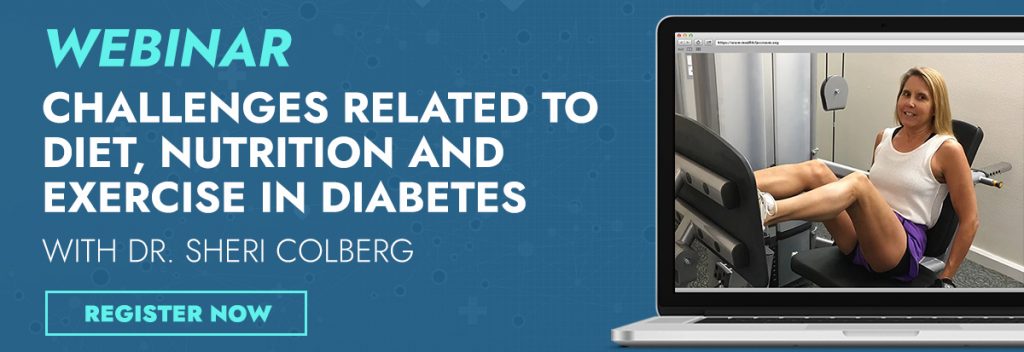Are you working with any clients who have type 1 diabetes, type 2 diabetes, or even prediabetes? Well, you have a lot to learn if you don’t know the first thing about those conditions! There are over 100 million Americans currently have diabetes or prediabetes—some of them are, or will be, your clients.

Diabetes is a metabolic disorder that results in elevated levels of blood glucose (“blood sugar”) that can cause many health complications if not managed effectively. Although exercise is one of the three cornerstones of diabetes management, sometimes it can complicate keeping blood glucose levels under control, especially in people who have to replace the insulin that their bodies no longer make (or make enough of). How they respond to being active really depends on the type of exercise and diabetes.
In any case, on a basic level, it’s good to know more about how exercise affects people with diabetes. I have lived well with type 1 diabetes for nearly half a century at this point, and I have always known at some level that exercise did good things for my blood glucose, even before I had my first blood glucose meter (after going 18 years without one). How could I tell without a meter to test my levels? Honestly, it was because being active always made me feel better, physically and emotionally.
I earned a PhD in Exercise Physiology to better understand how exercising helped me. You don’t have to go that far with your education, but if you have diabetes or are going to work with clients or patients who have it, here are some basic things that you really need to know.
#1: Exercise can help erase your blood glucose “mistakes”
- Exercise acts kind of like an extra dose of insulin.
- At rest, insulin is the main mechanism your body has to get glucose into muscle cells.
- During exercise, glucose goes your muscles without needing any insulin (via muscle contractions).
- Being regularly active makes your muscles more sensitive to insulin, so it takes less to have the same blood glucose lowering effect when you eat during or after exercise.
- What better way to help erase a little overeating of carbs (or some insulin resistance) than a moderate dose of exercise to lower your blood glucose?
#2: Exercise doesn’t always make your blood glucose go down
- It doesn’t always make your blood glucose come down, at least not right away.
- During intense exercise, the excess glucose-raising hormones your body releases can raise your blood glucose.
- Over a longer period of time (2-3 hours), it usually comes back down, but who wants to wait that long?
- If you take insulin, you’ll need to take less than normal to correct a post-workout high or your blood glucose will likely be crashing low a few hours later.
- A cool-down of less intense exercise (like walking) can help bring it back to normal, so do an easy, active cool-down after intense workouts or activities.
#3: Your muscles are critical to managing your blood glucose levels
- Exercise also helps you build and retain your muscle mass.
- Muscles are the main place you store carbs after you eat them—like a gas tank.
- Exercising helps use up stored carbs, but can also increase the size of the tank.
- When you eat carbs post-exercise, they can easily go into storage with a little insulin.
- Being sedentary keeps the tank full and makes you resistant to insulin.
- Aging alone can cause you to lose muscle mass over time, but you can combat it to a certain extent by recruiting all of your muscle fibers regularly.
- Resistance training and/or high-intensity intervals build muscle more because they
recruit the faster fibers that you don’t use when walking or doing easier activities.
#4: Exercise is the best medicine there is
- Use exercise to control stress and to stave off depression—with no bad side-effects!
- It’s a natural antioxidant—more effective and better than supplements!
- Being regularly active prevents all sorts of cancers.
- If you’re active, you’ll likely feel better and look younger than you are (as long as you don’t exercise too much).
- You’ll be even less likely to catch a cold if you exercise moderately and regularly.
- Standing more, taking extra steps, and fidgeting even help—be active all day long, and don’t forget your daily dose of the best medicine there is!
LEARN MORE: Join Dr. Colberg for her upcoming webinar, Challenges Related to Diet, Nutrition and Exercise in Diabetes
Sheri R. Colberg, PhD, FACSM, is a Professor Emerita of Exercise Science at Old Dominion University and a former Adjunct Professor of Internal Medicine at Eastern Virginia Medical School. She is an internationally recognized authority on diabetes and exercise. As a leading expert on diabetes and exercise, Sheri has put her extensive knowledge to use in founding Diabetes Motion (diabetesmotion.com), a website providing practical guidance about being active with diabetes. She also founded Diabetes Motion Academy (dmacademy.com), offering training and continuing education to fitness professionals.

